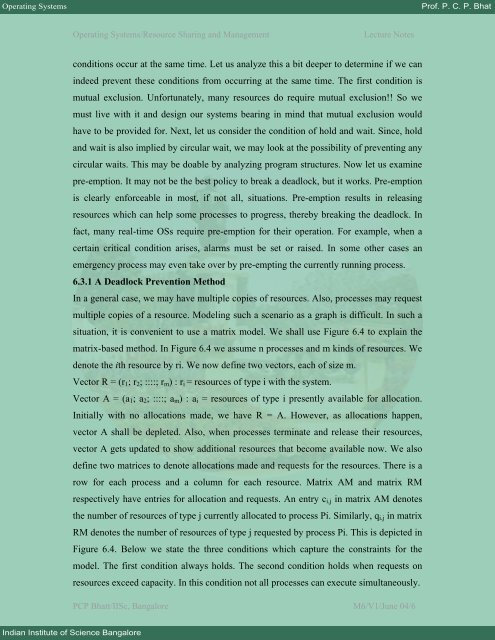Module 6: Resource Sharing and Management - E-Courses
Module 6: Resource Sharing and Management - E-Courses
Module 6: Resource Sharing and Management - E-Courses
Create successful ePaper yourself
Turn your PDF publications into a flip-book with our unique Google optimized e-Paper software.
Operating Systems Prof. P. C. P. Bhat<br />
Indian Institute of Science Bangalore<br />
Operating Systems/<strong>Resource</strong> <strong>Sharing</strong> <strong>and</strong> <strong>Management</strong> Lecture Notes<br />
conditions occur at the same time. Let us analyze this a bit deeper to determine if we can<br />
indeed prevent these conditions from occurring at the same time. The first condition is<br />
mutual exclusion. Unfortunately, many resources do require mutual exclusion!! So we<br />
must live with it <strong>and</strong> design our systems bearing in mind that mutual exclusion would<br />
have to be provided for. Next, let us consider the condition of hold <strong>and</strong> wait. Since, hold<br />
<strong>and</strong> wait is also implied by circular wait, we may look at the possibility of preventing any<br />
circular waits. This may be doable by analyzing program structures. Now let us examine<br />
pre-emption. It may not be the best policy to break a deadlock, but it works. Pre-emption<br />
is clearly enforceable in most, if not all, situations. Pre-emption results in releasing<br />
resources which can help some processes to progress, thereby breaking the deadlock. In<br />
fact, many real-time OSs require pre-emption for their operation. For example, when a<br />
certain critical condition arises, alarms must be set or raised. In some other cases an<br />
emergency process may even take over by pre-empting the currently running process.<br />
6.3.1 A Deadlock Prevention Method<br />
In a general case, we may have multiple copies of resources. Also, processes may request<br />
multiple copies of a resource. Modeling such a scenario as a graph is difficult. In such a<br />
situation, it is convenient to use a matrix model. We shall use Figure 6.4 to explain the<br />
matrix-based method. In Figure 6.4 we assume n processes <strong>and</strong> m kinds of resources. We<br />
denote the ith resource by ri. We now define two vectors, each of size m.<br />
Vector R = (r1; r2; ::::; rm) : ri = resources of type i with the system.<br />
Vector A = (a1; a2; ::::; am) : ai = resources of type i presently available for allocation.<br />
Initially with no allocations made, we have R = A. However, as allocations happen,<br />
vector A shall be depleted. Also, when processes terminate <strong>and</strong> release their resources,<br />
vector A gets updated to show additional resources that become available now. We also<br />
define two matrices to denote allocations made <strong>and</strong> requests for the resources. There is a<br />
row for each process <strong>and</strong> a column for each resource. Matrix AM <strong>and</strong> matrix RM<br />
respectively have entries for allocation <strong>and</strong> requests. An entry ci,j in matrix AM denotes<br />
the number of resources of type j currently allocated to process Pi. Similarly, qi,j in matrix<br />
RM denotes the number of resources of type j requested by process Pi. This is depicted in<br />
Figure 6.4. Below we state the three conditions which capture the constraints for the<br />
model. The first condition always holds. The second condition holds when requests on<br />
resources exceed capacity. In this condition not all processes can execute simultaneously.<br />
PCP Bhatt/IISc, Bangalore M6/V1/June 04/6

















